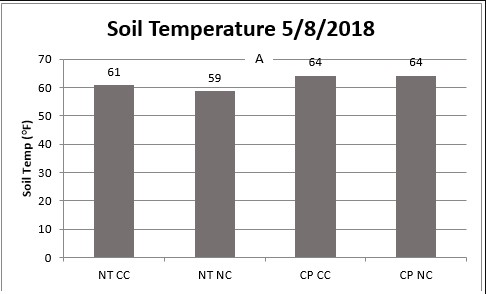By Mahdi Al-Kaisi
The amount of snow we received and potential spring rain events can be challenging to an early start to the growing season. Approaching field operations for N applications, tillage, weed control, etc. need to be weighed against potential soil compaction and successful seed germination. Two of the greatest concerns during spring is excess soil moisture and cold soil temperature and their impacts on seed germination, especially in areas with poorly drained soils as in northern and central Iowa. Areas with poorly drained soils can be managed with less tillage to ensure suitable soil conditions for plant growth. Tillage systems that manage residue and help warm the top two inches of the soil for seed placement to ensure successful seed germination may be considered. The most suitable system to achieve this is Strip-Tillage, where narrow-width tilled strips, traditionally created in the fall, can increase early spring soil evaporation and soil temperature in the top two inches. This is particularly effective in poorly drained wet soils, where slightly raised soil strips are created by normally available farm equipment such as anhydrous knives, disks, coulters, tool bars, or manure injection equipment.
Another practice that can be equally effective in improving wet and cold soil conditions early in the spring is the use of cover crops. Cover crops can serve as a mechanism to extract excess water from the topsoil, providing drier conditions that can contribute to the increase in soil temperature (Figure 1 & 2). Results from a recent study of tillage and cover crop (winter rye) demonstrate the impact of cover crop on increasing soil temperature and reducing moisture, especially with no-till (NT), where soil temperature increased by 2.1 °F degrees, but cover crop has less effect with chisel plow (CP) at the top two inches (Figure 1). The effect of both NT and cover crop in improving soil porosity and thus water infiltration and soil aeration is a contributing factor as compared to CP, where lack of soil permeability can limit cover crop effect on soil moisture (Figure 2). Soil temperature is highly influenced by soil moisture conditions, and any practice that removes excess moisture, especially early in the spring, can improve crop establishment and potentially reduce the effect of soil-borne diseases driven by cold temperatures. In conclusion, the best combination of tillage and cover crop appears to be when NT and cover crops are used to enhance the inherent best soil functions and properties provided by NT systems.
The challenges of wet conditions, especially in northern and central Iowa, which may exceed field capacity as shown in Figure 2 may require a comprehensive residue and other field management practices plan that may include but is not limited to:
- Consider residue management that ensures uniform residue distribution during harvest.
- Manage residue cutting height by setting the combine to leave corn stalks at 12 inches high.
- Avoid residue shredding to provide better aeration and soil moisture evaporation.
- Use minimum tillage alternatives such as ST, especially in the fall.
- Equip planter with residue cleaners or fluted coulters to help warm up the top few inches of soil.
- Include a well-designed field drainage system to help remove excess water.
- Incorporate perennial grasses within buffer strips and marginal areas to help extract excess moisture.
- Include a no-till system to improve soil structure, soil porosity, and removal of excess water.
- Incorporate cover crops as a mechanism to extract soil moisture, improve soil organic carbon, soil porosity, and contribute to warming up the top soil depth.

Figure 1. Soil temperature in the top two inches under no-till and chisel plow with and without rye cover crop on May 8, 2018. NT= no-till, CP= chisel plow, CC= cover crop, and NC= no cover crop.
Figure 2. Soil moisture in the top two inches under no-till and chisel plow with and without rye cover crop on May 8, 2018. NT= no-till, CP= chisel plow, CC= cover crop, and NC= no cover crop.